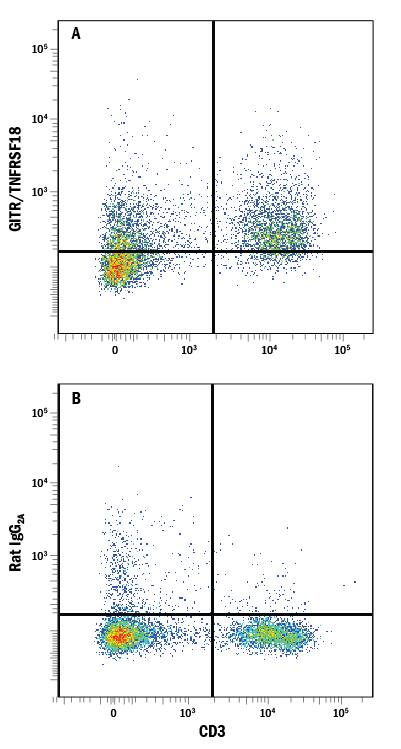Mouse GITR/TNFRSF18 Fluorescein-conjugated Antibody
Mouse GITR/TNFRSF18 Fluorescein-conjugated Antibody Summary
Met1-His153
Accession # O35714
Applications
Please Note: Optimal dilutions should be determined by each laboratory for each application. General Protocols are available in the Technical Information section on our website.
Scientific Data
 View Larger
View Larger
Detection of GITR/TNFRSF18 in Mouse Splenocytes by Flow Cytometry. Mouse splenocytes were stained with Rat Anti-Mouse CD3 APC-conjugated Monoclonal Antibody (Catalog # FAB4841A) and either (A) Rat Anti-Mouse GITR/TNFRSF18 Fluorescein-conjugated Monoclonal Antibody (Catalog # FAB5241F) or (B) Rat IgG2AFluorescein Isotype Control (Catalog # IC006F). View our protocol for Staining Membrane-associated Proteins.
Reconstitution Calculator
Preparation and Storage
Background: GITR/TNFRSF18
GITR (Glucocorticoid-Induced Tumor Necrosis Factor Receptor), also known as AITR, is a member of the co‑stimulatory subset of the TNF receptor superfamily (1, 2). In mouse, the GITR gene is composed of five exons and encodes multiple length isoforms that arise from alternate splicing. The “standard”, or first reported isoform is a type I transmembrane protein, 228 amino acids (aa) in length that contains a 19 aa signal sequence, a 134 aa extracellular region, a 21 aa transmembrane segment, and a 54 aa cytoplasmic domain. The extracellular region contains four potential N-linked glycosylation sites plus three cysteine-rich pseudorepeats of about 40 aa each (3, 4). The extracellular regions of mouse and human are 57% aa identical. The cytoplasmic domain has a P-x-Q/E-E motif that is known to associate with TRAF2. This is a common characteristic of TNFRSF members with co‑stimulatory functions (4). Three other mouse GITR isoforms (B, C and D) have been reported (5). All share the same N-terminal 101 of 134 aa in the extracellular region (including pseudorepeats #1, #2 and one-half of #3). Isoform D diverges at aa #101 and continues for another 12 aa for a total length of 113 aa. This is a naturally-occurring soluble form. Isoforms B and C show splicing in their cytoplasmic tails that creates cytoplasmic domains of 118 aa and 46 aa, respectively. In both the B and C isoforms, the TRAF2 binding site is spliced out, with a p56lck binding site inserted in isoform B (4). Given its membership in the TNFRSF, it likely functions as a trimer on the cell surface (2). GITR is predominantly expressed on CD4+CD25+ regulatory T cells (Treg) and naïve CD8+ and CD4+ CD25- T cells, where its expression is up-regulated after antigen-driven activation. GITR activation provides co‑stimulatory signals for activated CD4+ CD25- T cells to enhance cell proliferation and augment cytokine production (IL-2, IL-4, IFN-gamma ). On CD4+ CD25+ Treg cells, GITR activation provides co‑stimulatory signals to induce proliferation, setting Treg cells in an active/hyperproliferactive state (6‑8).
- Kwon, B. et al. (2003) Exp. Mol. Med. 35:8.
- Croft, M. (2003) Nat. Rev. Immunol. 3:609.
- Nocentini, G. et al. (1997) Proc. Natl. Acad. Sci. USA 94:6216.
- Nocentini, G. et al. (2000) DNA Cell Biol. 19:205.
- Nocentini, G. et al. (2000) Cell Death Differ. 7:408.
- Tone, M. et al. (2003) Proc. Natl. Acad. Sci. USA 100:15059.
- Ji, H. et al. (2004) J. Immunol. 172:5823.
- Stephens, G.L. et al. (2004) 173:5008.
Product Datasheets
Citations for Mouse GITR/TNFRSF18 Fluorescein-conjugated Antibody
R&D Systems personnel manually curate a database that contains references using R&D Systems products. The data collected includes not only links to publications in PubMed, but also provides information about sample types, species, and experimental conditions.
2
Citations: Showing 1 - 2
Filter your results:
Filter by:
-
Systemic CTLA-4 blockade ameliorates glioma-induced changes to the CD4+ T cell compartment without affecting regulatory T-cell function.
Authors: Fecci PE, Ochiai H, Mitchell DA, Grossi PM, Sweeney AE, Archer GE, Cummings T, Allison JP, Bigner DD, Sampson JH
Clin. Cancer Res., 2007-04-01;13(7):2158-67.
Species: Mouse
Sample Types: Whole Tissue
Applications: IHC -
A role for Dicer in immune regulation.
Authors: Cobb BS, Hertweck A, Smith J, O'Connor E, Graf D, Cook T, Smale ST, Sakaguchi S, Livesey FJ, Fisher AG, Merkenschlager M
J. Exp. Med., 2006-10-23;203(11):2519-27.
Species: Mouse
Sample Types: Whole Cells
Applications: Flow Cytometry
FAQs
No product specific FAQs exist for this product, however you may
View all Antibody FAQsReviews for Mouse GITR/TNFRSF18 Fluorescein-conjugated Antibody
There are currently no reviews for this product. Be the first to review Mouse GITR/TNFRSF18 Fluorescein-conjugated Antibody and earn rewards!
Have you used Mouse GITR/TNFRSF18 Fluorescein-conjugated Antibody?
Submit a review and receive an Amazon gift card.
$25/€18/£15/$25CAN/¥75 Yuan/¥2500 Yen for a review with an image
$10/€7/£6/$10 CAD/¥70 Yuan/¥1110 Yen for a review without an image

